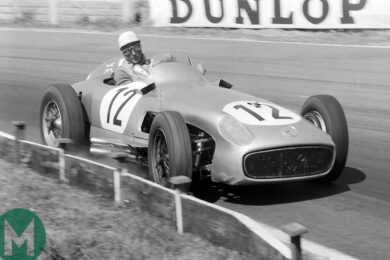Moss is the anomaly in this list – the intruder, you might say – because he never won the World Championship. To me, that diminishes only the worth of the title: I think Stirling the greatest of them all, no matter the points, no matter the country.
“If Moss had put reason before passion,” Enzo Ferrari said, “he would have been World Champion many times.” So he would – but he wouldn’t then have been Stirling Moss. The attraction of driving, in his later years, for Rob Walker was not simply that they were friends; there was the added frisson of beating the factory teams as a privateer. And now, he says, as he looks back he rather likes the fact that he never became World Champion; an inherently modest man, he will never say he was the best of his era – but he was.
Although Moss’ driving style was very different from Villeneuve’s, there is much that links the two, much that explains the devotion they drew from the fans. Gilles was the racer pure, and for all his artistry Stirling, too, will say that he prides himself primarily as a racer, rather than driver.
At the time of his last accident at Goodwood – unexplained half a century on – he was laps behind after a pitstop, but going flat out because there was still a lap record to be had, still something to be taken from the day. And still spectators to be entertained, of course. If you were a Moss fan at a race track, you never went home dissatisfied.
To picture Stirling at his zenith, conjure if you will an image of one with the style and ease of Prost and the passionate genius of Villeneuve. At his peak – which he was to the last day of his career – Moss’ driving was essentially without flaw, and he was plainly quicker than the rest. Wet or dry, fast circuit or slow, it didn’t matter, and it was the same with cars. When Cooper and then Chapman revolutionised Grand Prix racing, Stirling effortlessly adapted: in 1956 he won at Monaco in a 250F, and four years later did it again in a Lotus 18.
Through my childhood Moss was a national hero, a sportsman revered like Matthews or Compton, yet through all that time his phone number was in the book – as it is to this day. He never felt he should be isolated, he said: if someone, be it a fan or Alfred Neubauer, wished to contact him, he was available. Hard to believe in the context of 2012.
Overwhelmingly, Stirling personified ‘racing driver’. Fundamentally a shy man, he never found it easy to face a crowded room, to make a speech or whatever – even though he had the charisma to still that room simply by walking in. At a circuit he was different again, always walking quickly – on the balls of his feet – and absolutely in his own environment.
Again, though, he was marvellous with the fans. In the paddock that day at Oulton he asked me if I’d like to sit in the Maserati, and smilingly posed by the car as my dad took a picture. In an instant he became a hero, and although I have considered him a friend for nigh on 40 years, a hero he remains.
There was a purity in the way Moss went racing. Like most of his contemporaries, he had no great mechanical knowledge, and if a car wasn’t behaving itself, he simply drove around the problems.
He was also quintessentially a sportsman, which sounds passé in the world of today, but was highly valued in his own time. It is well documented that, thanks to the point-scoring system of the time, Moss lost the 1958 World Championship by a point to Hawthorn, despite winning four Grands Prix to Mike’s one. Less remembered is that had he not voluntarily gone to the stewards at Oporto, and spoken up in Hawthorn’s defence, his rival would have been disqualified. Suggest that it was a remarkably selfless thing to do, and he looks bemused.
Moss was perhaps at his greatest in 1961, his last full season, when he put his virtuosity to work at Monaco and the Nürburgring, archetypal driver’s circuits both, and beat the more powerful Ferraris in Walker’s obsolete Lotus-Climax.
Then, with an abruptness I can remember to this day, it all ended at Goodwood. As Stirling’s life hung in the balance, fans across the world tremblingly listened to news bulletins, willing him to survive.

